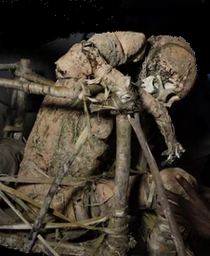The chief, shaman, and warrior named Moimango, had been mummified with smoke in the 1950s. Moimango is one of 23 mummies currently housed in the gallery on Koke Mountain, about 300m above the village of Koke in Papua New Guinea. His son, Gemtasu, is the clan leader of the village of Koke. Gemtasu says that he would like someday to sit next to his father, looking out over his fellow Anga people from the cliff. Mummies placed along the cliff in the gallery are said to protect and look out for their village. It is also done out of respect for the deceased and for some political reasons.
Mummification[]
The mummification process is a very long and tedious process. There are many steps involved that require a considerable amount of time and effort to ensure that the effort being made is to maintain the mummies so the villagers' relationship with death is still close. The process begins with opening the pores with hot water. Then, an anal spicket is used to remove any unwanted products. This is to enhance the desiccation process. After, the body is put on a smoked body sling and placed inside a hut which is designated for the smoking process. A bush rope is used to secure and support the body. Next, a smokey fire is produced that allows all bodily fluids to be extracted and released. The fluids are collected in a small tray on the bottom and then clay is placed into the tray. The clay is rubbed on the bodies as ornamentation and a ritualistic way. The Kukia plant is continued to be rubbed on the body to encourage more fluid out of the body. Usually family members conduct this process. In this case, Gemtasu, Moimango's son, was apart of his father's mummification process. This process required constant attentions and lasts for approximately 30 days. Furthermore, during the mummification, they would change the position of the body to ensure that all parts were completely drained. This completes the process of the mummification. The smoked mummies at then placed on high up cliffs or mountains in a mummy gallery where they overlook the village.
However, it is evident that the years had not been kind to Moimango. There are times when the mummies are brought down from the mountains during events and celebrations and this puts the mummies at greater risk for damage. Moimango had a dislodged jaw and a drooping head in danger of completely falling off. Lichens had also infiltrated the body, and at one point, a rodent had burrowed into Moimango's side, making a nest inside. Therefore, Dr. Ronald Beckett and his team used bark cloth called tapa to patch and support body parts, such as the jaw and the head. Also, they continued to repair any necessary parts using a sap from the kumaka tree as glue. The team killed the lichens that has spread along Moimango with a lime-based substance called suca made from crushed shells, which has the same pH as bleach.This prevented the lichens from re-emerging in the future years.
Studies[]
Dr. Ronald Beckett and his colleague Andrew Nelson of the University of Western Ontario in Canada wanted the Anga to be able to maintain the restorations themselves. So, in 2008, the team arrived and asked villagers to identify suitable restoration materials from the jungle. They assisted in the facial reconstruction and other repairs to the smoked mummies. Moreover, Beckett and his team also witnessed the mummification of a forest pig in order to better understand the smoking process.
Pathology[]
Despite the fact that Moimango was 68 years of age when he passed away, he appeared to have been in good overall bony and dental health. However, he he did experience some periodontal disease. Moimango apparently died upon return from a hunt or battle, complaining of having “short wind” which could have possibly been malaria, anthracosis, emphysema or pneumonia.
Additional[]
Dr. Ronald Beckett was very fascinated with the Anga mummies. He mentioned how they were still a part of village life, not ancient artifacts as they are in Egypt. In fact, members of the village introduced Beckett and his team to the mummies as if they were living people. Today, in the western society, people might pray to their deceased loved ones, or visit their graves and talk to them. However, the Anga had no traditional concept of the afterlife. They believed that their spirits roamed around the forest and maybe came back and haunted them a bit. Although, if the spirits of great people whose bodies are not taken care of may roam the jungle and cause problems for hunting or crops. By preserving the deceased person's body, they are able to still see the face and if they could still interact in that sense, then their spirit was still with them. Thus, mummification is a way to the ‘see the face’ and therefore derive comfort/advice/power from the honored deceased. However, the spiritual connection is lost if the face is not preserved.
References[]
Ghose, T. (2015, May 22). In Photos: The Smoked Mummies of Papua New Guinea. Retrieved from <http://www.livescience.com/50948-photos-smoked-mummies-papua-new-guinea.html>
Ghose, T. (2015, May 22). Smoked Mummy Helps Villagers Connect with 'Ghost World'. Retrieved from <http://www.livescience.com/50947-smoked-mummies-papua-new-guinea.html>
Nelson, A.J., Lywood, V. & Beckett, G. (2010). Facial reconstruction of an Anga mummy. Retrieved from <http://www.victorialywood.com/uploads/Nelson_et_al_-_CAPA_2010_poster_-_handout-_Web.pdf>
Stannard, E. (2010, August 31). Village mummy ritual withstands test of time: Quinnipiac prof tells of trips in National Geographic. Retrieved from <http://www.nhregister.com/general-news/20100831/village-mummy-ritual-withstands-test-of-time-quinnipiac-prof-tells-of-trips-in-national-geographic>
